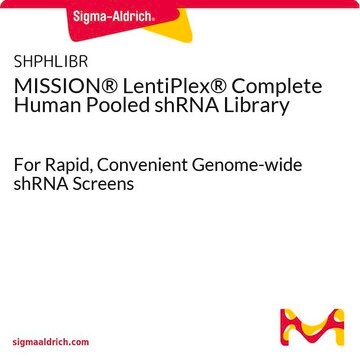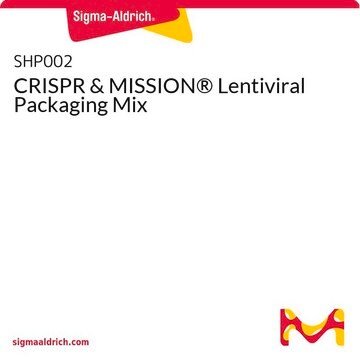おすすめの製品
包装
pkg of 8x25 μL (vials)
濃度
5x108 VP/ml (via p24 assay)
テクニック
capture ELISA: 5 × 108 TU/mL using p24
輸送温度
dry ice
保管温度
−70°C
関連するカテゴリー
詳細
This ready-to-use MISSION TRC3 Human LentiORF pooled library allow for stable integration, enrichment of cells, and long-term gene expression in difficult-to-transfect cell lines utilizing our best-in-class lentiviral manufacturing. This collection provides researchers with the unique tools to gain insights into gene function through modulating gene and protein expression.
The classical genetic approach for exploring biological pathways typically begins by identifying mutations that cause a phenotype of interest. Overexpression or misexpression of a wild-type gene product, however, can also cause mutant phenotypes, providing geneticists with an alternative yet powerful tool to identify pathway components that might remain undetected using traditional loss-of-function analysis. The whole genome lentiviral ORF pool fills this gap and provides researchers with a powerful research tool for carrying out crucial biological experiments.
Whether looking to perform gene overexpression studies or validate gene knockdown/knockout results from an RNAi or CRISPR experiment, LentiORFs are the ideal shortcut to protein expression and tool for gene analysis. Researchers also need to validate “hits” from a screen to confirm to eliminate false positives. This means confirming whether the observed phenotype is due the target gene of interest. Re-expressing the gene of interest via lentiORFs is the most accepted way to validate a gene target.
MISSION TRC3 Human LentiORF pooled whole genome library is provided in 8×25 μl aliquots at a minimum titer of 5×108 TU/ml (measured by a p24 assay).
アプリケーション
特徴および利点
- Efficiently screen the whole human genome (~12,000 genes) at the bench-top without robotics or specialized equipment
- Pre-cloned, sequence confirmed, expression-ready clones
- Ideal Shortcut to Protein Expression: Use Pooled Lentiviral ORFs to express protein-coding genes to assess their function
- Simple Deconvolution: The puromycin library is barcoded, consisting of a 24 nucleotide sequence located downstream of the V5 tag and translation stop. Each clone contains a unique barcode sequence that can be easily identified, allowing for simple deconvolution of pooled screening experiments
- EF1a promoter drives expression of the ORF construct, offering an alternative to the CMV promoter which may not be appropriate in certain cell types
- Puromycin resistance allows for double selection experiments in cells containing Neomycin or Blasticidin resistance
- Enriched population of cells: Use puromycin selection after transduction, for creation of a long term-stable cell line
- V5 epitope tag facilities pull-down and co-immunoprecipitation experiments to determine protein-protein interactions or label and visualize ORFs via immunofluorescence
- Positive and negative selection controls (BFP and GFP) are provided, which allow researchers to confidently gauge the success of their pooled screening experiments
- Lentiviral ORFs can infect a broad variety of mammalian cells (including difficult to transfect or primary cell lines) via transduction to facilitate gene overexpression for screening applications
- Rapid and affordable screening with easy-hit identification via Sigma-Aldrich′s deconvolution service
- Save time: Skip PCR, cloning, and DNA sequence verification steps
調製ノート
その他情報
法的情報
保管分類コード
12 - Non Combustible Liquids
WGK
WGK 3
引火点(°F)
Not applicable
引火点(℃)
Not applicable
試験成績書(COA)
製品のロット番号・バッチ番号を入力して、試験成績書(COA) を検索できます。ロット番号・バッチ番号は、製品ラベルに「Lot」または「Batch」に続いて記載されています。
この製品を見ている人はこちらもチェック
資料
This screening guide covers how to choose a cell line, a screening library, and experimental conditions as well as tips for designing and performing your experiment.
このスクリーニングガイドには、細胞株、スクリーニングライブラリ、および実験条件の選択方法と、実験を計画および実行するためのヒントが記載されています。
Deconvolute pooled shRNA samples post-screening to identify significant TRC clones with our service.
Our lentiviral vector systems are developed with enhanced safety features. Numerous precautions are in place in the design of our lentiviruses to prevent replication. Good handling practices are a must.
プロトコル
Lentivirus versions of genome modification technologies support successful CRISPR, RNAi, and ORF experiments.
FACS sorts cells based on light scattering and fluorescence for objective cell analysis.
ライフサイエンス、有機合成、材料科学、クロマトグラフィー、分析など、あらゆる分野の研究に経験のあるメンバーがおります。.
製品に関するお問い合わせはこちら(テクニカルサービス)












